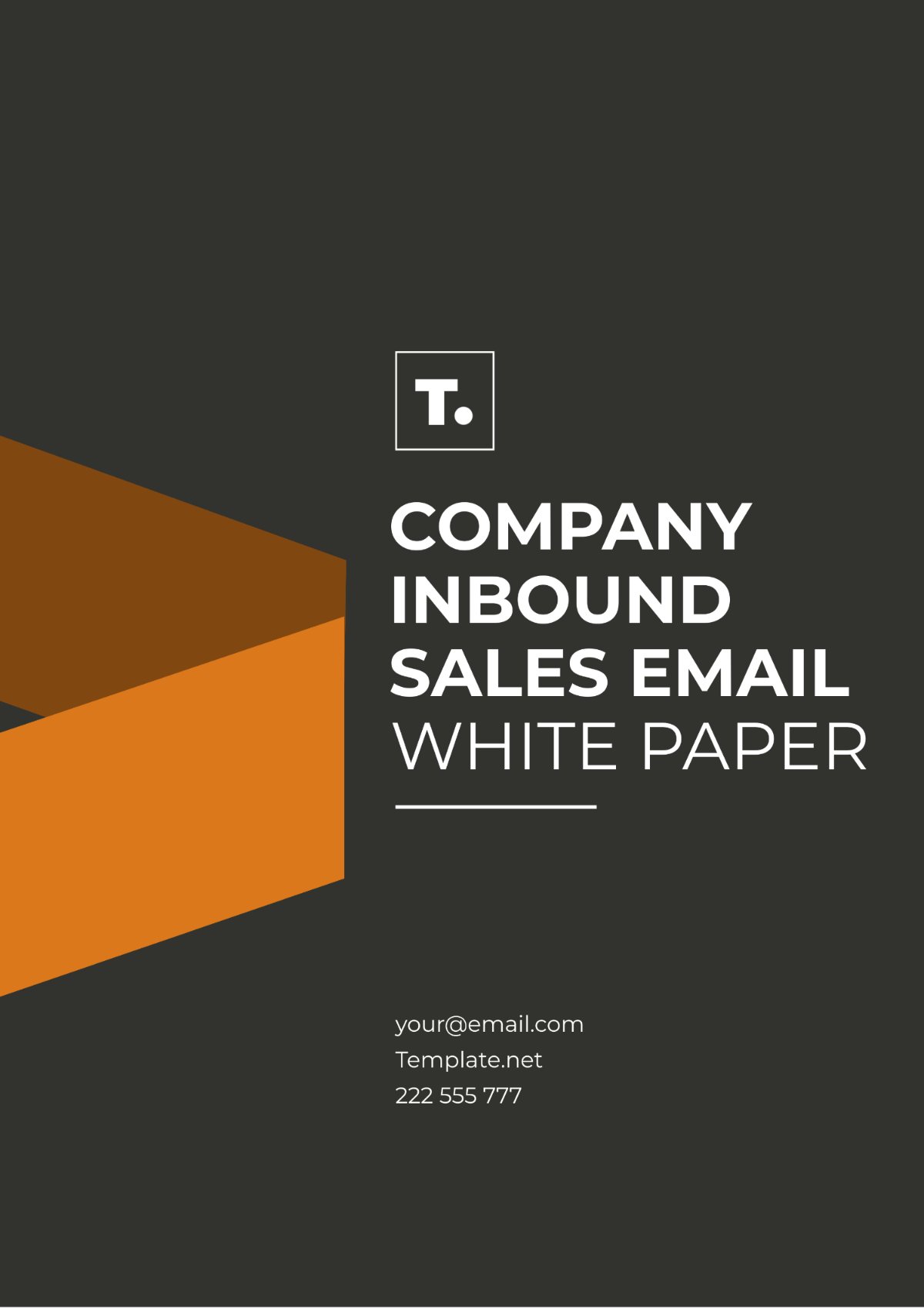Free Company Inbound Sales Email White Paper

Mastering Inbound Sales Emails for Successful Engagement
I. Executive Summary

In today's digital age, the art of effective communication in sales has evolved. Inbound sales emails have emerged as a powerful tool for engaging with potential customers and guiding them through the sales funnel. This white paper explores the importance of inbound sales emails, strategies for crafting compelling messages, and best practices for implementing an effective inbound sales email strategy.
II. Introduction
Inbound sales emails are personalized messages sent to potential customers who have shown interest in a product or service. Unlike traditional cold emails, inbound sales emails are tailored to the recipient's needs and preferences, making them more likely to convert leads into customers.
III. Understanding Inbound Sales Emails
A. Definition and Purpose
Inbound sales emails are part of an inbound marketing strategy aimed at attracting and engaging potential customers through relevant and helpful content. Their purpose is to educate, inform, and persuade recipients to take a specific action, such as making a purchase or scheduling a demo.
B. Benefits of Inbound Sales Emails
Increased Engagement: Inbound sales emails are more likely to be opened and read than cold emails, leading to higher engagement rates.
Better Targeting: By targeting recipients who have already expressed interest, inbound sales emails are more likely to resonate with the audience.
Higher Conversion Rates: When done correctly, inbound sales emails can lead to higher conversion rates and ultimately, more sales.
IV. Crafting Effective Inbound Sales Emails
A. Identifying Target Audience
To craft effective inbound sales emails, it's essential to understand your target audience's needs, preferences, and pain points. Conducting market research and creating buyer personas can help tailor your messages to resonate with your audience.
B. Personalization Techniques
Personalization is key to creating effective inbound sales emails. Use the recipient's name, company name, and other relevant information to make your emails more personalized and engaging.
C. Compelling Subject Lines
The subject line is the first thing recipients see when they receive an email. A compelling subject line can increase open rates and encourage recipients to read the email. Use power words, numbers, and personalization to create compelling subject lines.
D. Body Content Strategies
The body of your email should be concise, engaging, and informative. Use bullet points, short paragraphs, and visuals to make your content easy to read and understand. Highlight the benefits of your product or service and include a clear call to action.
V. Implementing an Inbound Sales Email Strategy
A. Tools and Technologies
There are several tools and technologies available to help you implement and manage your inbound sales email strategy. These include email marketing platforms, CRM software, and analytics tools.
B. Metrics and Analytics
Key metrics to track and analyze include open rates, click-through rates, conversion rates, and ROI. Use this data to optimize your email campaigns and improve performance over time.
Chart 1. Email Performance Metrics
C. A/B Testing
A/B testing involves sending two versions of an email to see which performs better. This can help you optimize your emails for maximum effectiveness.
VI. Case Studies
Case Study 1: [COMPANY A NAME]
Industry: Software as a Service (SaaS)
Challenge: [COMPANY A NAME] wanted to increase conversions from their inbound sales emails.
Solution: [COMPANY A NAME] implemented a personalized email marketing strategy, using data-driven insights to tailor their messages to individual recipients.
Result: [COMPANY A NAME] saw a 30% increase in email open rates and a 20% increase in conversion rates within six months.
Case Study 2: [COMPANY B NAME]
Industry: E-commerce
Challenge: [COMPANY B NAME] was struggling to re-engage with dormant customers.
Solution: [COMPANY B NAME] developed a targeted email campaign aimed at re-engaging dormant customers with personalized offers and recommendations.
Result: [COMPANY B NAME] saw a 25% increase in sales from re-engaged customers and a 10% increase in overall revenue.
VII. Conclusion
Inbound sales emails are a valuable tool for engaging with potential customers and driving sales. By understanding your audience, personalizing your messages, and using compelling content, you can create effective inbound sales emails that convert leads into customers.
VIII. Additional Resources
For further reading on inbound sales email strategies, check out the following resources:
[YOUR COMPANY BLOG POST ON INBOUND SALES EMAILS]
[YOUR COMPANY WEBINAR ON CRAFTING EFFECTIVE EMAILS]
[YOUR INDUSTRY REPORT ON EMAIL MARKETING TRENDS]
For inquiries or assistance, please contact:
[YOUR NAME]
[YOUR COMPANY NAME]
[YOUR COMPANY ADDRESS]
[YOUR DEPARTMENT]
- 100% Customizable, free editor
- Access 1 Million+ Templates, photo’s & graphics
- Download or share as a template
- Click and replace photos, graphics, text, backgrounds
- Resize, crop, AI write & more
- Access advanced editor
The Company Inbound Sales Email White Paper Template from Template.net, editable in our Ai Editor Tool, is perfect for businesses looking to improve their inbound sales strategies. Whether you're targeting new leads or nurturing existing ones, this customizable template helps you create compelling and engaging sales emails that drive results.





























